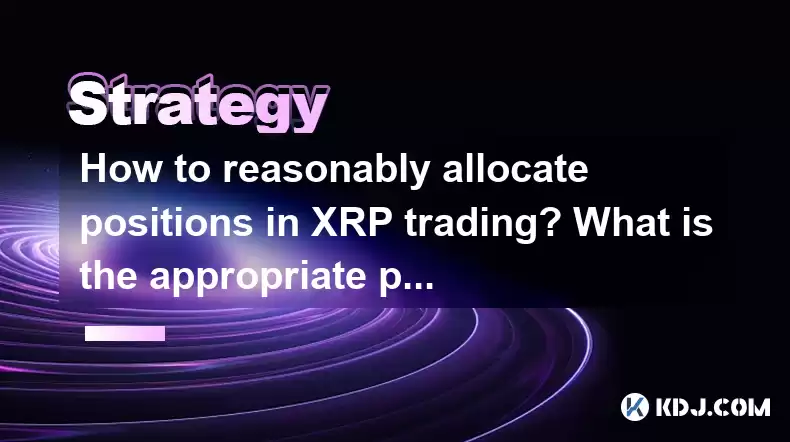-
 bitcoin
bitcoin $110918.433029 USD
-1.69% -
 ethereum
ethereum $3996.872473 USD
-2.43% -
 tether
tether $1.000594 USD
0.00% -
 bnb
bnb $1178.871834 USD
-2.38% -
 xrp
xrp $2.413973 USD
-3.47% -
 solana
solana $194.341461 USD
-4.24% -
 usd-coin
usd-coin $0.999963 USD
-0.03% -
 tron
tron $0.320092 USD
0.92% -
 dogecoin
dogecoin $0.196919 USD
-3.42% -
 cardano
cardano $0.669585 USD
-3.63% -
 hyperliquid
hyperliquid $37.485952 USD
-3.58% -
 ethena-usde
ethena-usde $1.000026 USD
-0.02% -
 chainlink
chainlink $18.018220 USD
-5.13% -
 bitcoin-cash
bitcoin-cash $523.879267 USD
-2.41% -
 stellar
stellar $0.324655 USD
-3.67%
How to reasonably allocate positions in XRP trading? What is the appropriate proportion of each investment
When trading XRP, allocate 10-20% for short-term gains, 5-10% for long-term growth, and 3-5% in a diversified crypto portfolio to manage risk effectively.
May 04, 2025 at 05:43 am

Trading XRP, like any other cryptocurrency, requires a strategic approach to position allocation to manage risk and optimize potential returns. In this article, we will explore how to reasonably allocate positions in XRP trading and discuss the appropriate proportion of each investment.
Understanding Position Allocation in XRP Trading
Position allocation refers to the distribution of your total investment capital across different trades or assets. In the context of XRP trading, this means deciding how much of your capital to allocate to XRP and how to spread that allocation across different trading strategies or timeframes. Proper allocation helps in managing risk and maximizing returns.
When considering XRP, it's important to understand its volatility and market behavior. XRP is known for its rapid price movements, which can be both an opportunity and a risk. Therefore, a well-thought-out allocation strategy is crucial.
Factors to Consider in Allocating Positions
Several factors should influence your position allocation in XRP trading:
- Risk Tolerance: Your comfort level with potential losses will dictate how much you are willing to allocate to XRP. If you have a low risk tolerance, you might allocate a smaller portion of your portfolio to XRP.
- Investment Goals: Whether you are looking for short-term gains or long-term growth will affect your allocation strategy. Short-term traders might allocate more to XRP to capitalize on its volatility, while long-term investors might allocate less.
- Market Conditions: The current state of the cryptocurrency market, including trends and sentiment towards XRP, should guide your allocation decisions.
- Diversification: Spreading your investments across different assets can reduce risk. Even within XRP trading, you might diversify across different strategies or timeframes.
Determining the Appropriate Proportion of Each Investment
The appropriate proportion of each investment in XRP trading can vary based on individual circumstances, but here are some general guidelines:
- Short-Term Trading: If you are engaging in short-term trading, you might allocate 10-20% of your total trading capital to XRP. This allows you to take advantage of its volatility while keeping risk manageable.
- Long-Term Investment: For long-term investment, a more conservative approach might be suitable. Allocating 5-10% of your portfolio to XRP can provide exposure to its potential growth without exposing you to excessive risk.
- Diversified Portfolio: If you are building a diversified cryptocurrency portfolio, you might allocate 3-5% of your total portfolio to XRP. This allows you to benefit from XRP's performance while maintaining a broad exposure to other cryptocurrencies.
Strategies for Allocating Positions in XRP Trading
Here are some strategies to consider when allocating positions in XRP trading:
- Dollar-Cost Averaging (DCA): This strategy involves investing a fixed amount of money at regular intervals, regardless of the price. For XRP, you might decide to allocate a certain percentage of your monthly investment budget to XRP. For example, if you allocate 10% of your monthly investment to XRP, you can buy more XRP when the price is low and less when the price is high, averaging out your cost over time.
- Position Sizing: This involves determining the size of each trade based on your total capital and risk tolerance. A common rule of thumb is to risk no more than 1-2% of your total capital on any single trade. For XRP, if you have a $10,000 trading account, you might risk $100-$200 per trade.
- Scaling In and Out: This strategy involves gradually increasing or decreasing your position size based on market conditions. For example, you might start with a small position in XRP and increase it as the market moves in your favor. Conversely, you might reduce your position size as the market moves against you.
Implementing Position Allocation in XRP Trading
To implement position allocation in XRP trading, follow these steps:
- Assess Your Risk Tolerance: Determine how much risk you are willing to take. This will help you decide the overall percentage of your portfolio to allocate to XRP.
- Set Your Investment Goals: Decide whether you are looking for short-term gains or long-term growth. This will influence your allocation strategy.
- Analyze Market Conditions: Keep an eye on the overall cryptocurrency market and specific trends related to XRP. This will help you adjust your allocation as needed.
- Diversify Your Portfolio: Even within XRP trading, consider diversifying across different strategies or timeframes. This can help manage risk.
- Implement Your Strategy: Use the strategies mentioned above, such as DCA, position sizing, and scaling in and out, to allocate your positions in XRP trading.
Monitoring and Adjusting Your Allocations
Once you have allocated your positions in XRP trading, it's important to monitor and adjust them as needed. Here are some tips:
- Regularly Review Your Portfolio: Check your XRP positions regularly to ensure they align with your risk tolerance and investment goals.
- Adjust Based on Performance: If XRP is performing well, you might consider increasing your allocation. Conversely, if it's underperforming, you might reduce your allocation.
- Stay Informed: Keep up with news and developments related to XRP and the broader cryptocurrency market. This can help you make informed decisions about your allocations.
Frequently Asked Questions
Q: Can I allocate more than 20% of my portfolio to XRP if I have a high risk tolerance?A: While it's possible to allocate more than 20% of your portfolio to XRP if you have a high risk tolerance, it's important to consider the potential for significant losses. Even with a high risk tolerance, it's generally advisable to maintain a diversified portfolio to mitigate risk.
Q: How often should I adjust my XRP allocations?A: The frequency of adjusting your XRP allocations depends on your trading strategy and market conditions. For short-term traders, adjustments might be more frequent, while long-term investors might adjust their allocations less often. It's important to review your portfolio regularly and make adjustments based on performance and market trends.
Q: Is it better to allocate a fixed percentage of my portfolio to XRP or adjust it based on market conditions?A: Both approaches have their merits. Allocating a fixed percentage can provide a disciplined approach to investing, while adjusting based on market conditions can help you capitalize on opportunities and manage risk. A combination of both strategies might be the most effective approach, where you start with a fixed allocation and adjust it as needed based on market conditions.
Q: Should I consider using leverage when allocating positions in XRP trading?A: Using leverage can amplify both gains and losses, making it a high-risk strategy. If you decide to use leverage, it's crucial to allocate a smaller percentage of your capital to XRP and to have a clear risk management plan in place. For most traders, it's advisable to avoid leverage or use it sparingly.
Disclaimer:info@kdj.com
The information provided is not trading advice. kdj.com does not assume any responsibility for any investments made based on the information provided in this article. Cryptocurrencies are highly volatile and it is highly recommended that you invest with caution after thorough research!
If you believe that the content used on this website infringes your copyright, please contact us immediately (info@kdj.com) and we will delete it promptly.
- Larry Fink and BlackRock: Tokenizing All the Assets, Baby!
- 2025-10-16 11:05:12
- Meme Coin Mania: MoonBull, FLOKI, and SHIB – What's the Buzz?
- 2025-10-16 09:10:00
- Pepeto's Presale Success: Riding the Crypto Bull Run Wave
- 2025-10-16 08:30:01
- Affordable GPUs for Gamers: A 2025 Deep Dive
- 2025-10-16 10:25:12
- Coinbase, BNB, and Token Listings: A New Era?
- 2025-10-16 09:25:16
- Secure Enclave, Flow, and Launch: What's the Buzz?
- 2025-10-16 08:30:01
Related knowledge

Practical parameter settings for a Bitcoin multi-timeframe moving average system
Sep 18,2025 at 10:54pm
Optimizing Timeframe Combinations for Bitcoin Trading1. Selecting appropriate timeframes is crucial when building a multi-timeframe moving average sys...

How can I filter out false breakouts in Dogecoin high-frequency trading?
Sep 22,2025 at 01:00am
Understanding False Breakouts in Dogecoin Trading1. A false breakout occurs when Dogecoin's price appears to move beyond a defined support or resistan...

Techniques for identifying tops and bottoms in the Bitcoin on-chain NVT model
Sep 20,2025 at 07:54pm
Understanding the NVT Model in Bitcoin Analysis1. The Network Value to Transactions (NVT) ratio is often described as the 'P/E ratio' of the cryptocur...

What does the surge in open interest in Bitcoincoin futures mean?
Sep 20,2025 at 11:18pm
Understanding the Surge in Dogecoin Futures Open Interest1. A surge in open interest within Dogecoin futures indicates a growing number of active cont...

How can I use the Ethereum USDT premium to gauge market sentiment?
Sep 18,2025 at 11:55pm
Understanding the Ethereum USDT Premium1. The Ethereum USDT premium refers to the price difference between USDT (Tether) traded on Ethereum-based plat...

What should I do if Ethereum staking yields decline?
Sep 20,2025 at 06:18am
Understanding the Causes Behind Declining Ethereum Staking Yields1. The Ethereum network transitioned to a proof-of-stake consensus mechanism with the...

Practical parameter settings for a Bitcoin multi-timeframe moving average system
Sep 18,2025 at 10:54pm
Optimizing Timeframe Combinations for Bitcoin Trading1. Selecting appropriate timeframes is crucial when building a multi-timeframe moving average sys...

How can I filter out false breakouts in Dogecoin high-frequency trading?
Sep 22,2025 at 01:00am
Understanding False Breakouts in Dogecoin Trading1. A false breakout occurs when Dogecoin's price appears to move beyond a defined support or resistan...

Techniques for identifying tops and bottoms in the Bitcoin on-chain NVT model
Sep 20,2025 at 07:54pm
Understanding the NVT Model in Bitcoin Analysis1. The Network Value to Transactions (NVT) ratio is often described as the 'P/E ratio' of the cryptocur...

What does the surge in open interest in Bitcoincoin futures mean?
Sep 20,2025 at 11:18pm
Understanding the Surge in Dogecoin Futures Open Interest1. A surge in open interest within Dogecoin futures indicates a growing number of active cont...

How can I use the Ethereum USDT premium to gauge market sentiment?
Sep 18,2025 at 11:55pm
Understanding the Ethereum USDT Premium1. The Ethereum USDT premium refers to the price difference between USDT (Tether) traded on Ethereum-based plat...

What should I do if Ethereum staking yields decline?
Sep 20,2025 at 06:18am
Understanding the Causes Behind Declining Ethereum Staking Yields1. The Ethereum network transitioned to a proof-of-stake consensus mechanism with the...
See all articles


























![Web3 Crypto Market Morning Report: The market is in decline, altcoins have fallen by more than 5%, Binance compensation has been received, and Memes on the Bnb chain have collectively plummeted [Vic TALK Issue 1444] Web3 Crypto Market Morning Report: The market is in decline, altcoins have fallen by more than 5%, Binance compensation has been received, and Memes on the Bnb chain have collectively plummeted [Vic TALK Issue 1444]](/uploads/2025/10/16/cryptocurrencies-news/videos/web-crypto-market-morning-report-market-decline-altcoins-fallen-binance-compensation-received-memes-bnb-chain-collectively-plummeted-vic-talk-issue/68f043c9c8b44_image_500_375.webp)















































